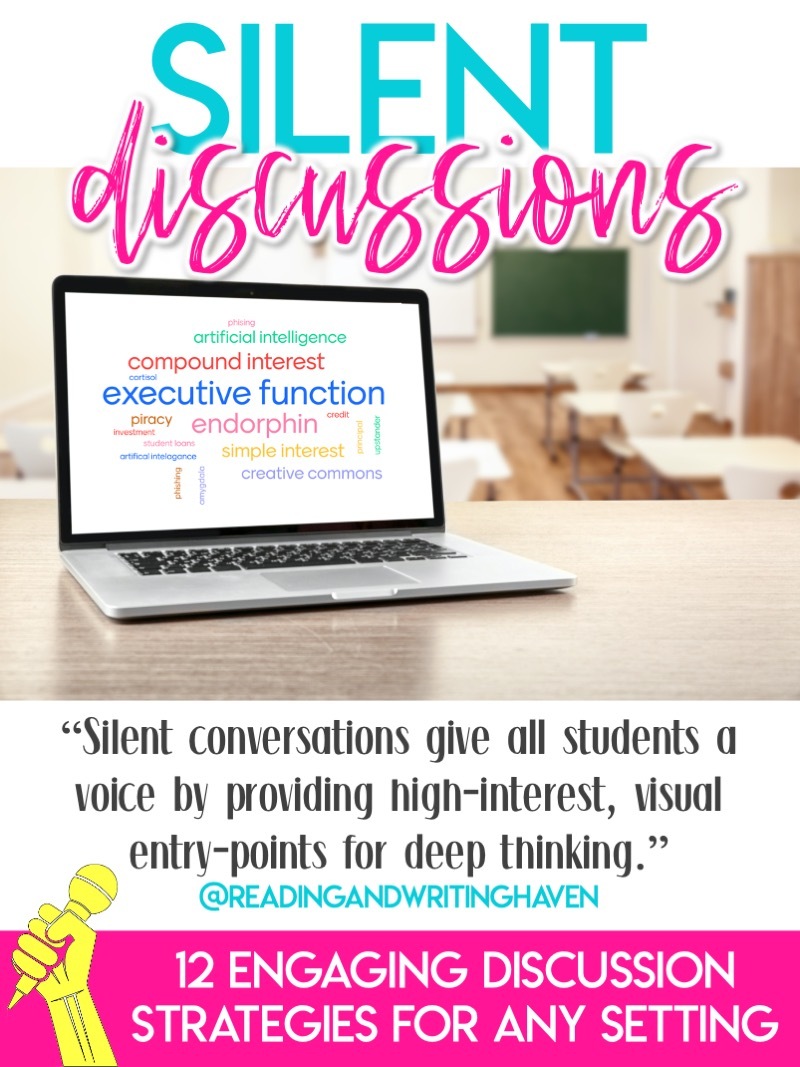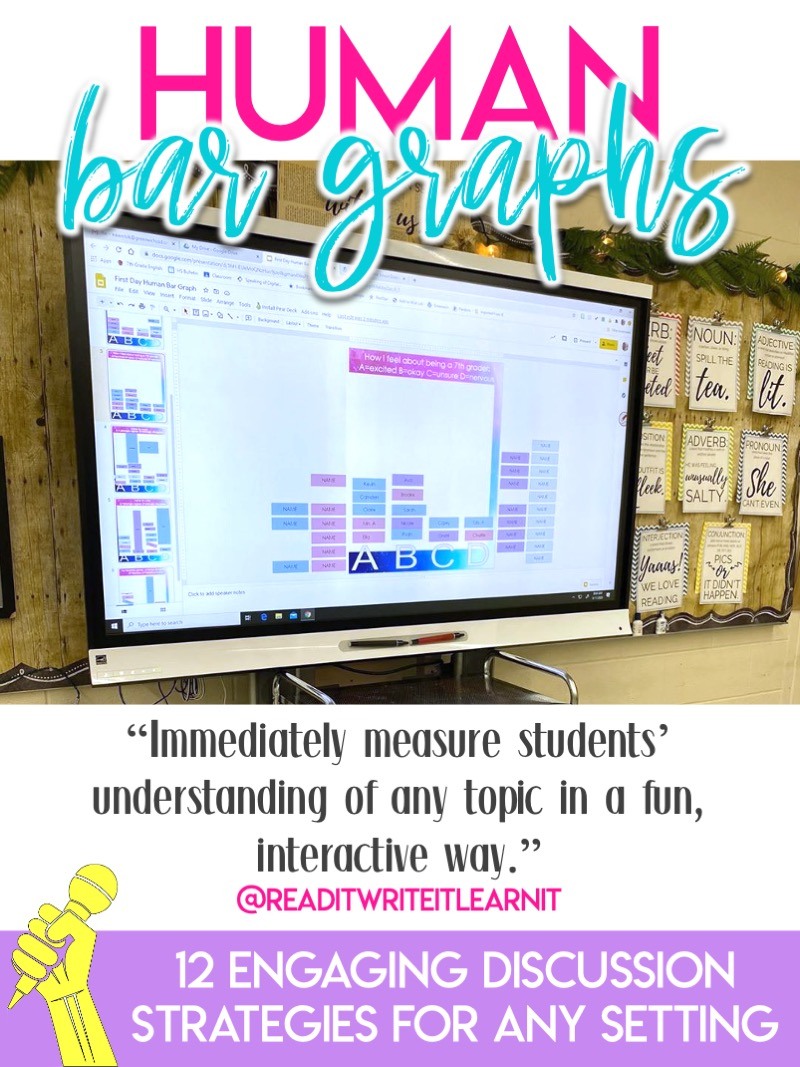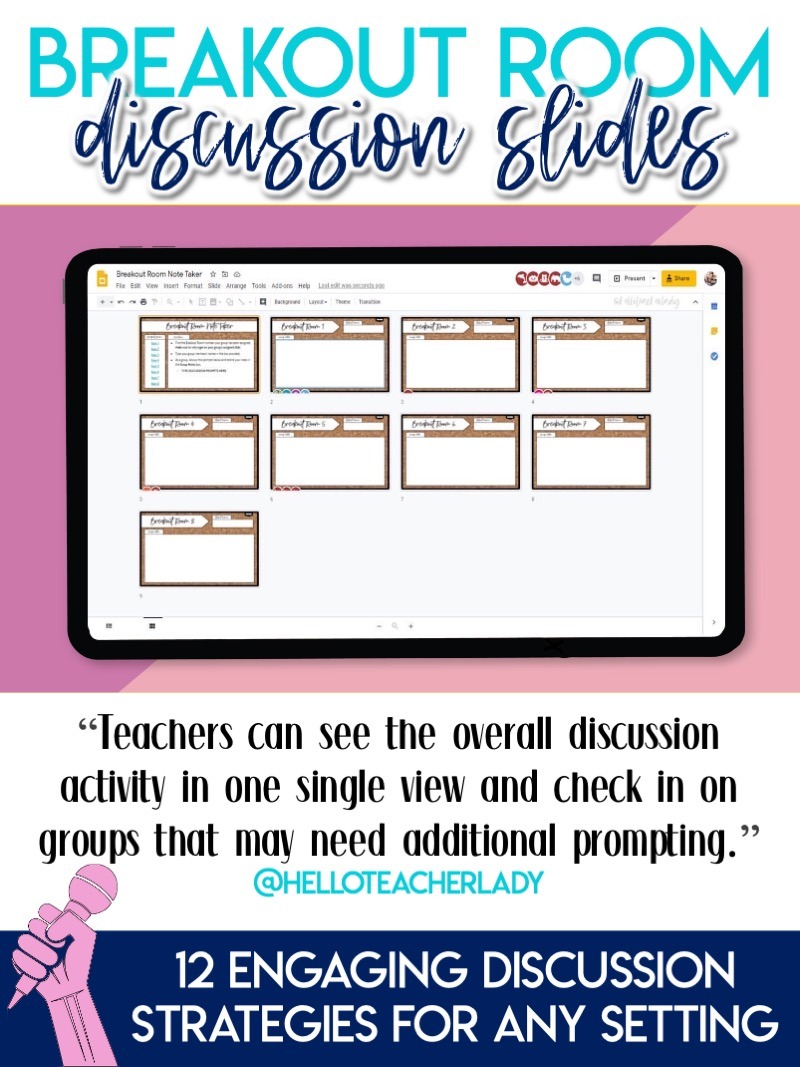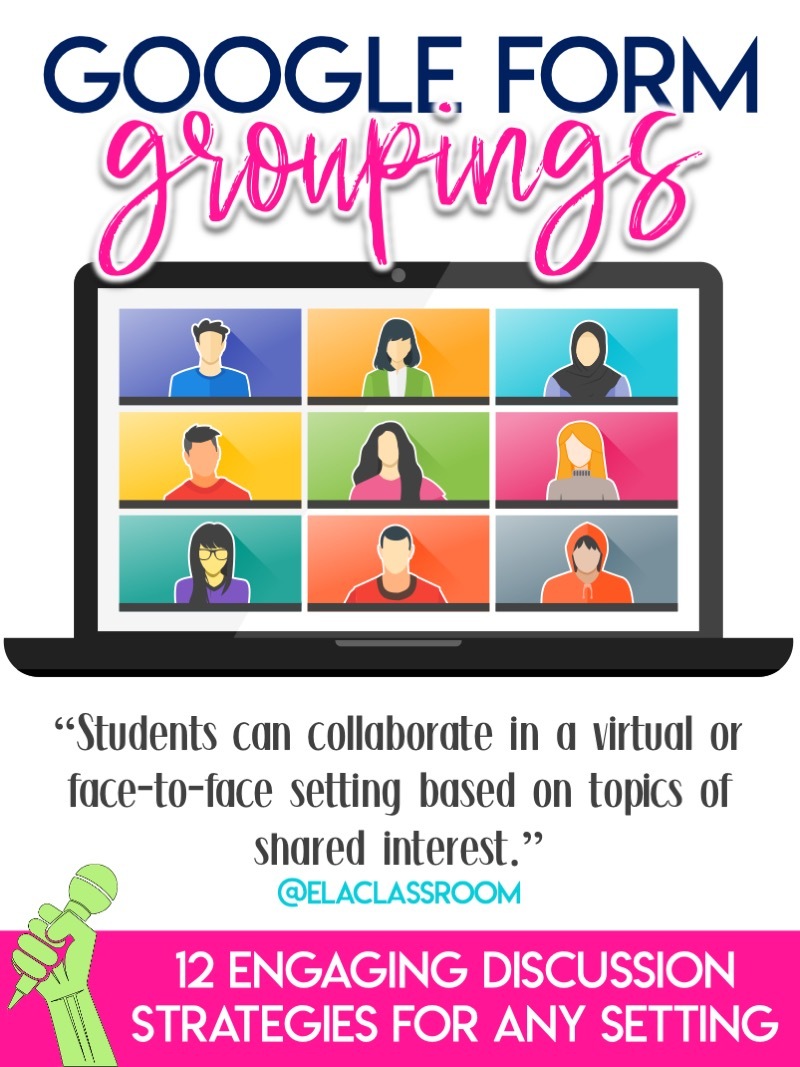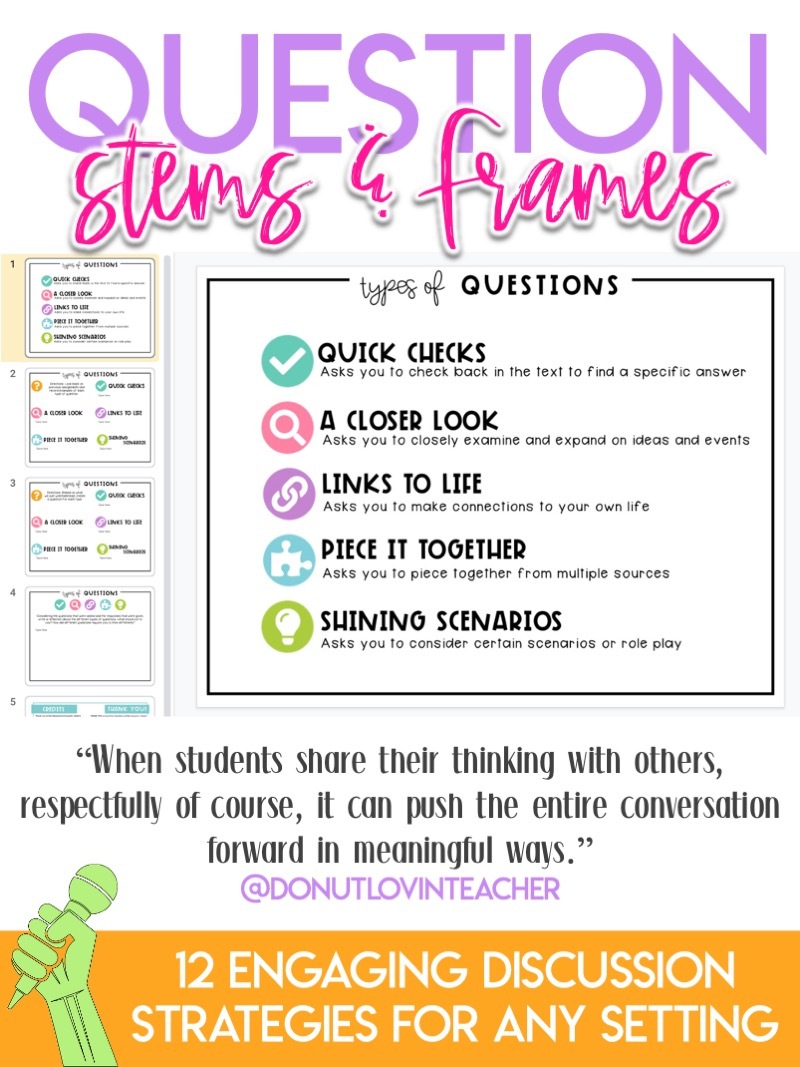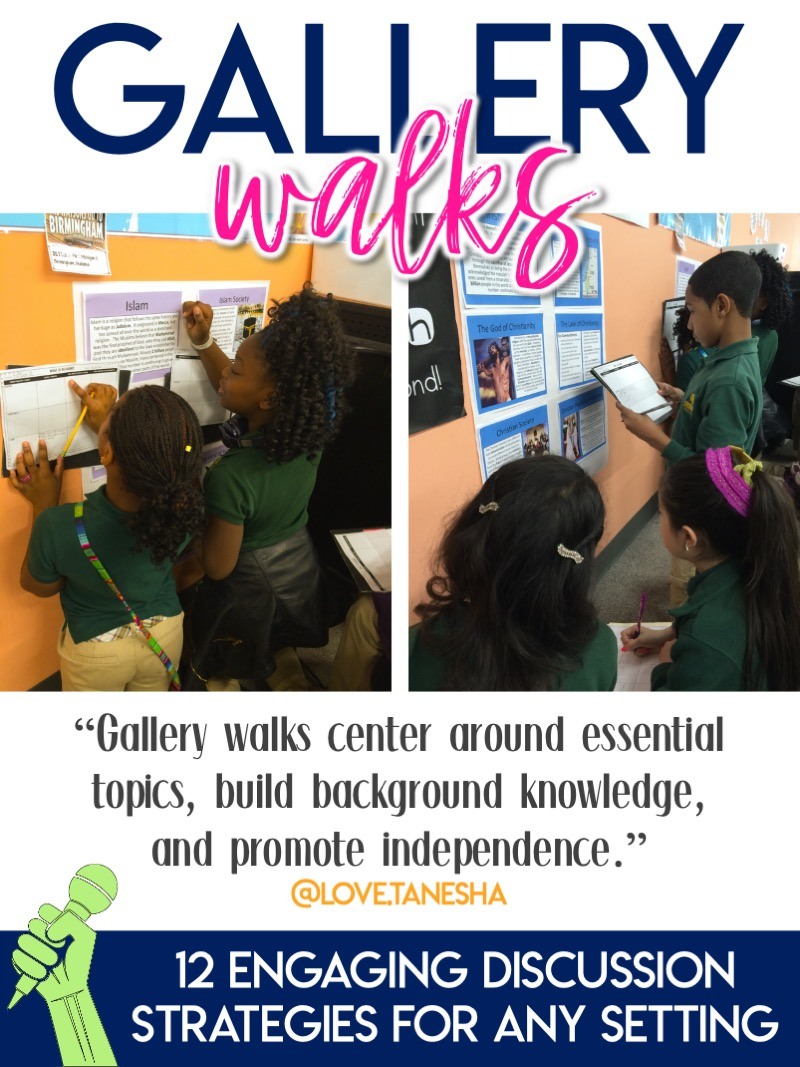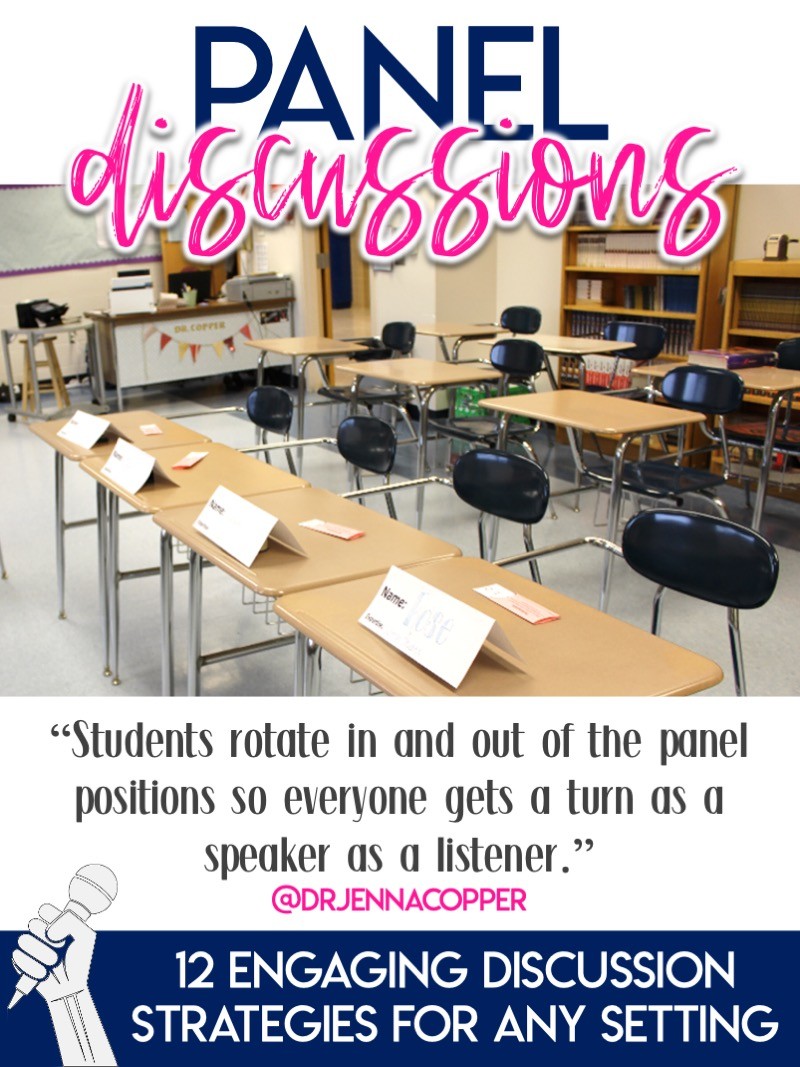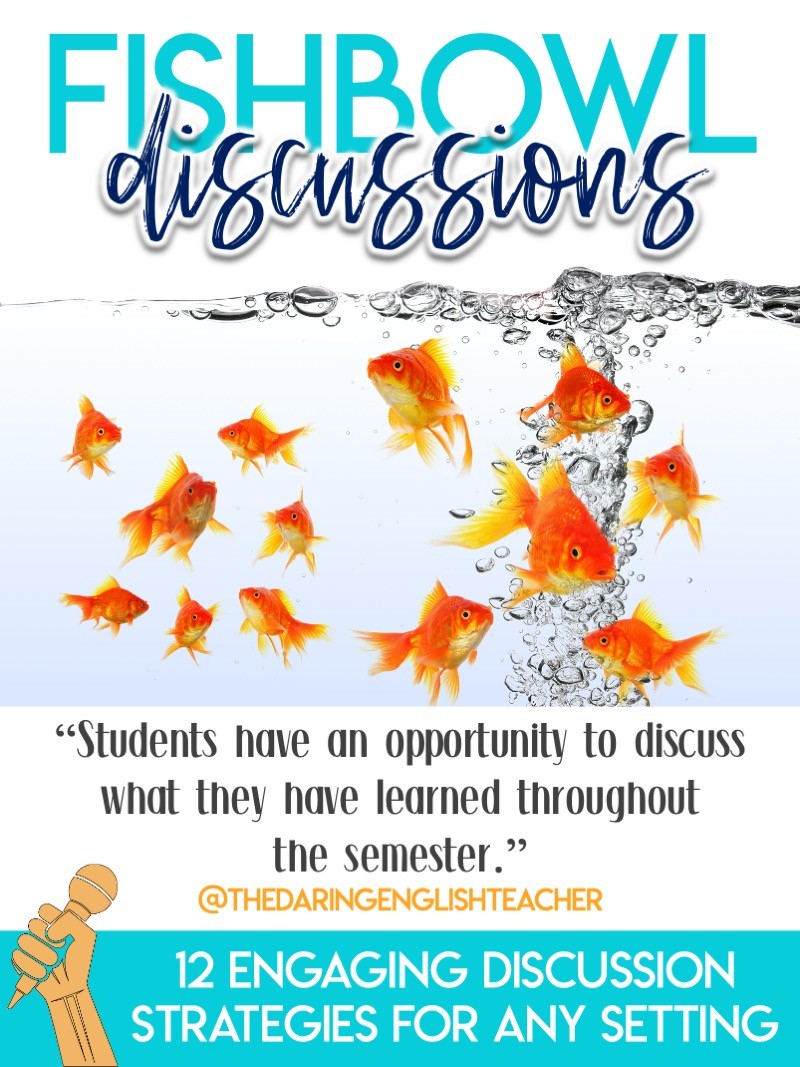12 Powerful Discussion Strategies to Engage Students
Inside: Looking for collaborative class discussion strategies that work across settings? This post is full of a variety of engaging technology and formatting options for blended learning, online teaching, and face-to-face instruction.
Whether you have students at home, in school, or BOTH at the same time, you’re probably looking for ways to engage tweens and teens in meaningful conversations. Discussion strategies are changing. With the demands of social distancing and multiple settings, teachers are getting creative, looking for ways to bring students together, even when we are apart.
I wanted to compile a fresh list of inspiration for online discussions, so I reached out to some of my middle and high school teacher friends around the web. The result? This post is FULL of classroom-tested discussion strategies for collaborative conversations. You’ll find a variety of tech tools that bridge the gap between home and school as well as formatting ideas for how to run whole-class and small-group discussions.
CLASS DISCUSSION STRATEGIES: TECH IDEAS
When it comes to technology, sometimes less is more. BUT! If students and teachers know how to use technology to make discussions efficient and effective, they can be just what you need to host meaningful class conversations across settings. These discussion strategies utilize tech tools that enhance learning and connectedness.
1. Silent Discussions
Silent discussion strategies have been gaining momentum in the physical classroom, but they are also convenient for online discussions.
Consider…students with devices where the microphones may or may not work? Noisy distractions in the home environment? Students tuning in live from home with other students sitting in the classroom?
Silent discussions can bridge the gap.
How it works:
In order to make a virtual or blended learning silent discussion work, we first have to select the technology we need. In person, teachers often use big paper or graffiti walls. So, I started brainstorming how those engaging techniques can transfer to online learning.
A few options…
With Mentimeter, teachers can create a variety of poll questions to engage students in a variety of settings. You can create your interactive questions in different formats: word clouds, rankings, spider webs, bar charts, quadrants, word walls, and more. Teachers can create three-slide presentations for free. Students have easy access on any device by navigating to menti.com and then typing in the code at the top of the page.
Padlet is another tech platform teachers can use to hold silent discussions. Students can synchronously or asynchronously post original ideas in response to discussion questions in grid, timeline, map, wall, column, and other arrangements. One of the best parts is that students can post links to related articles or videos and original photographs they’ve taken. Plus, they can build on their peer’s posts to create an ongoing conversation.
Finally, Backchannel chat is a convenient, free chat-style tool. While students are having a discussion either in person or online, non-verbal participants can be talking via the backchannel chat. I recommend – if possible – having two screens so that you can view students’ faces on one (if you have students at home) and the backchannel chat on another.
Why it works:
Each of these silent discussion tech tools provides an avenue for students at home to be engaging with students at school. And, when all students are in the classroom together, they provide intentional avenues to give each student ownership and a voice in the discussion.
2. Color-Coded Conversations
Whether teaching ELA remotely or in person, Ashley Bible of Building Book Love makes it a point to provide ample opportunity for shy students to thrive. One of her go-to silent discussion strategies is a Color-Coded Conversation using a shared document.
How it works:
- Set up a shared doc with a table that will fit all of your students plus the topics you want them to discuss. For example, a 4×30 table if you have 30 students and want to discuss three points.
- Instruct students to choose a UNIQUE color, font, or combo for their name. This specific color/font will follow them throughout the discussion.
- Have students give their points in their own boxes then move to other boxes to continue the conversation.
Why it works:
Students LOVE getting to choose their own font and colors while experiencing the novelty of multiple people typing on the same doc. Teachers benefit by being able to quickly scan and follow the color-coded contributors! You see this process in action on the second slide here and find more lively discussion strategies from Ashley here: How to Liven Up Your Socratic Seminar.
3. Human Bar Graphs
The human bar graph is a great way to immediately measure ELA students’ understanding of any topic in a fun, interactive game for the classroom or a Google Meet/Zoom.
How it works face-to-face:
Before social distancing, Emily from Read it. Write it. Learn it. used the Human Bar Graph by placing A, B, C, and D labels at the front of the classroom. Emily would display a question with four possible answer choices on her SmartBoard. These choices could be opinions (agree/disagree) or fact based (one correct answer) options. Students would then stand in a row at their answer forming a Human Bar Graph.
Virtual options:
Now, Emily uses the Human Bar Graph digitally. It takes some prep work, but once it’s done, you’ll have it to reuse over and over. You can save time by grabbing a pre-made version here.
To create a Human Bar Graph, open a Google Slide with a custom page setting of 8.5×11 inches. Post a question at the top and A, B, C, D answer choices at the bottom. Insert a rectangle just small enough for a student to write their name. Then, right click and copy and paste enough rectangles on the page for the number of students you have in class.
Share this slide with students through Google Classroom as an assignment using the Students Can Edit option. Once students are in the slide together (up to 50 can work together at one time), instruct them to write their name on one rectangle. That rectangle will be theirs to click and drag.
Now, the fun begins! Read a multiple choice question slowly and carefully so all students can hear the question and answer choices. Read answer choices a second time if necessary. Then, tell students to move their rectangles to choice A, B, C, or D.
To add drama and excitement, you could give students who volunteer the opportunity to place their rectangles and explain their thinking before letting the whole class loose!
After finishing your human bar graph, be sure to discuss patterns and what those patterns might reveal.
Why it works:
Beyond traditional multiple choice, the Human Bar Graph is also a great survey tool. Give students a statement and have them rank how much they agree or disagree (A = strongly agree; D = strongly disagree). Use the answer choices to share opinions about a text or topic. For example, A could represent The character survived because of luck. B could represent The character survived because of his own perseverance, etc.
Your students will love interacting in real time, and the discussions that follow will be rich!
4. Collaborative Note Catchers
If you’re looking for a way to facilitate and keep track of small group discussions, Shana Ramin from Hello, Teacher Lady recommends using Google Slides as a collaborative note catcher.
How it works:
Simply create a slideshow with one slide for each small group and change the sharing permissions to “Anyone with the link can edit.” Once students have the link, they’ll be able to type on their group’s assigned slide as they discuss the prompt in small groups.
Why it works:
The best part? The slides are easy to monitor in real time using the Grid View in Google Slides. This allows teachers to see the overall discussion activity in one single view and check in on groups that may need additional prompting. You can learn more and grab Shana’s free note taker templates here.
5. Virtual Questions
If you’ve been searching for a platform for online discussion boards, the answer might be right in front of you: Google Classroom. While Classroom does not have a specific “discussion board” feature, Abby from Write on With Miss G has found a way to “hack” Google Classroom questions so they function as discussion boards.
How it works:
When you use a Google Classroom question, students can reply to each other in the comments, which makes this feature a discussion board of sorts. Just make sure to check “Students can reply to each other” in the bottom right-hand corner (although it should default to this setting). You, too, can join your students’ discussion and ask guiding questions to move their conversation forward.
You can ask one essential question, give students a choice of questions to answer, or even ask students to submit their own questions for their peers to answer (like a virtual Socratic Seminar). Whatever you do, you’ll want to make sure that you clearly communicate and model expectations for responding to peers so that students don’t end up merely commenting “I agree” and “Same, bro!”
Why it works:
While this strategy works well for fully virtual learning, it’s also a great option for traditional, flipped, or hybrid learning. You can start class with a silent, virtual discussion board, and then use students’ responses as a springboard for an in-class discussion. Or, you can assign a discussion board after a chapter of reading homework and let students learn from each other before you fill in the gaps during a whole-class discussion the following day.
These online discussion boards are powerful because they give all learners a voice in a low-risk setting. You can read more about how Abby structures and facilitates these online discussions HERE.
6. Google Form Groupings
Google Forms are such a simple and easy tool for teachers and students alike.
If you have not created Google Forms before, Lauralee walks you through the process in her digital classroom blog post.
How it works:
Primarily, she uses Google Forms to organize students into groups; students answer one or two questions based on classroom studies. After you pose a question in the Form, decide how you’d like students to answer. You can choose a multiple choice, short answer, or longer essay option.
Lauralee typically provides multiple choice options. Then when students respond, she separates students into groups based on their similar ideas. Often, Lauralee creates a Google Slides presentation for each group that is labeled after the multiple choice responses.
Why it works:
Students can then collaborate in a virtual setting, and they already are familiar with the topic since they answered the question similarly. Google Forms are quick to make, and the data is simple to process (especially with the multiple choice and checkbox features), which makes it a time-saving tool.
CLASS DISCUSSION STRATEGIES: FORMATS
When it comes to configuring students into different formats (both virtually and in-person), the sky is the limit.
7. Question Stems + Sentence Frames
Have you ever sent students into a discussion and they were done in the blink of an eye? An integral aspect of any of these discussion strategies is student readiness.
Staci (@DonutLovinTeacher) often asks her students to engage in Socratic Seminars, digital discussion boards, or in Book Clubs. However, before expecting students to know how to have these kinds of discussions, Staci and her students examine the impact of types of questions and responses.
How it works:
To better support all of her students, Staci has conversations with her students about types of questions. Staci shares different kinds of questions with her students and asks them to look through previous assignments to find examples. Based on a short video or text, they practice asking different kinds of questions and her students are able to see first hand how the questions lead to very different discussions.
Furthermore, Staci finds it valuable to provide and practice using different kinds of sentence frames that will help students “think out loud.” When students share their thinking with others, respectfully of course, it can push the entire conversation forward in meaningful ways. Leave these frames up in a digital or in-person setting for students to reference throughout the discussion. Sometimes a little preparation and support can go a long way!
Why it works:
Students need scaffolding. Quality discussion skills are often not intuitive. We can explicitly teach students about the nuances of eloquent conversations by scaffolding and modeling. Gradually, as students internalize these concepts and they become second nature, students will be more independent.
8. Gallery Walks
In the spirit of co-creating learning, Tanesha (@love.tanesha) uses gallery walks to engage students around essential topics and to build background knowledge.
How it works:
There are several ways to organize gallery walks, which depend on the desired outcome and topic. Teachers can create gallery walks by arranging a mix of photos and images around the room in stations. Students are grouped and rotate between stations with a specific focus. One of the most important considerations is having enough rich content for students to engage with that invites divergent thinking and conversations.
Teachers can leverage this activity virtually using the same tactics, and leveraging breakout rooms, Google hangouts, or a similar tool for students to interact with one another.
Why it works:
One of the most inviting elements of a gallery walk is how it engages various learning styles and promotes independence. It’s a simple activity with tremendous outcomes for students. Tanesha has found that it works for her shy and outgoing students!
9. Panel Discussions
Inspired by a popular political show, Jenna (@drjennacopper) developed panel discussions as one of he favorite classroom discussion strategies. A panel discussion is made up of three roles: a moderator who asks questions (a student or the teacher), panelists (four to five students), and the audience (the rest of the class).
How it works:
The moderator guides the discussion, and the panelists function as “experts” on the topics for discussion.
Like a fishbowl discussion, students rotate in and out of the panel positions throughout the discussion so everyone gets a turn as a speaker and a listener. (Students rotate out of the panel when they’ve fulfilled the speaking and listening requirements.)
To add another layer of complexity, the audience can partake in a virtual discussion to mimic “tweeting,” which often happens during panel discussion. Jenna uses a shared Google Doc or Backchannel Chat for her audience members.
Why it works:
All students are involved in the discussion. The variety of three different roles keeps things fresh. Teachers can be involved as little or as much as necessary, and throughout the year, they can scaffold panel discussions to full, student-led conversations.
To learn more about the steps for making students the experts in panel discussions, you can read more here.
10. Team Packs
It’s no surprise that kids love novelty, so when Staci from @theengagingstation handed her students these super fun, bright, and bubbly team packs, they were instantly intrigued.
How it works:
In face-to-face instruction, these team packs are a great way to foster collaborative discussion. Simply print one question on a piece of paper and insert it into a team pack. Students will work together to answer the question, then pack up their team pack and pass it on to the next group. When the next group receives it, they must add to the discussion answers by adding more analysis, text evidence, conclusions, and more.
How can this work digitally? Staci has found great success so far in the digital school year of using props. You can simply hold one of these fancy team packs on your camera display and pull out a question, or you could consider creating a Google Slide template that students can interactively click on to “open” the team pack (and it’ll take them to a slide with a question!).
Why it works:
Team packs are an easy way to add simple engagement. In just a short amount of time, students can answer several text-based questions, work collaboratively, revisit texts, and fall in love with shiny bubble mailers…or whatever packaging you choose to utilize.
You can read more about team packs and how Staci made them on her blog.
11. Socratic Seminar Variations
Socratic Seminar might be one of the most important instructional discussion strategies that an ELA teacher can learn and implement in her classroom. The driving force of a socratic seminar? INQUIRY.
How it works:
To develop a seminar, Amanda from Mud and Ink Teaching recommends starting with an Essential Question. Essential Questions are questions that guide units of study and illicit genuine curiosity and further inquiry from students (check out this blog post for a head start or her course to learn more!).
Once you have your question written, you’ll need to find texts that all speak to the question, and the more variety, the better! A novel study, art, TED Talks, poetry, and nonfiction are all texts that students can read and interpret ahead of time and then bring into the seminar discussion when it’s time.
Once students are prepared with the EQ, any smaller sub questions, and the texts, it’s time to invite them into the discussion.
Face-to-Face: To host a socratic seminar in the classroom, arrange desks in a circle and discussion begins (this Teaching Channel video is an amazing starting place!).
Virtual: Amanda has also hosted her socratic seminars using Google Docs and the platform Parlay with great success.
Why it works:
No matter the platform or design, what makes socratic seminars so powerful, is that the students are the only ones doing the talking, the answering, and the leading. The teacher’s job is to sit at the periphery of the room, take anecdotal notes, and listen for the conversation to naturally build and deepen in complexity as it carries on.
Socratic seminars take practice, but Amanda promises that the more often her class does them, the better they get every time! If you need inspiration for your questions and texts, Amanda has you covered!
12. Fishbowl Discussions
One way that Christina, The Daring English Teacher, loves to get students engaged in meaningful classroom conversations is through fishbowl discussions. She holds fishbowl discussions every semester to provide students with an opportunity to discuss what they’ve learned during the semester.
How it works:
To set up a fishbowl discussion, she places two tables facing each other in the center of the classroom and then rearranges all of the other tables in a big circle around the two tables. Essentially, she creates a fishbowl.
Students then volunteer to go into the center of the fishbowl to answer the discussion questions. It is good to have four students enter the fishbowl at a time so that they can discuss each question and engage in a back-and-forth conversation as they answer the question.
To tie the discussion back to classroom content, The Daring English Teacher makes sure that the students not only answer the question, but they must also provide examples or evidence. This way, students can build off of one another with multiple examples to answer one question.
Why it works:
This discussion strategy can easily be modified to fit online formats. To modify the fishbowl discussion virtually, teachers can use this digital Socratic Seminar Google resource to help students engage in a meaningful, socially-distanced or Zoom classroom conversation.
Students can volunteer to join the discussion, and as they discuss the questions (which can also be posted in the chat feature), the students who are listening can take notes about what each speaker says and contributes to the discussion.
And that makes TWELVE meaningful teacher- and student-tested conversation modes for middle and high school students. We hope you find this big list of classroom discussion strategies helpful for whatever unique challenges you are facing this year.
READ NEXT:
-
10 ELA Lesson Plans that Engage Students Any Time of Year
-
10 Creative ELA Lesson Strategies
-
Literary Analysis Activities to Elevate Thinking

